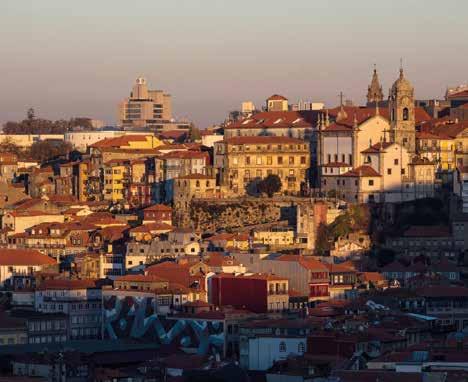
13 minute read
Travel
from American in Britain Winter 2022/23
by American in Britain magazine and The American Hour website
Porto, Portugal Featuring The M.Ou.Co Hotel
Porto is Portugal’s second city and is probably best known for giving its name to a popular drink (take the o off!), a fortified wine often enjoyed by many after a meal. It also has the best football team in Portugal, which started the glittering career of Jose Mourinho, well known for managing Real Madrid, Chelsea and Manchester United, to name just a few. But did you know that Porto is one of the oldest European centres, and its centre was proclaimed a World Heritage Site by UNESCO in 1996?
Porto is just being discovered as a city break destination, but its history dates back over the centuries as it is strategically placed at the point where the Duoro river flows into the Atlantic Ocean, and it also has some wonderful beaches, making it an all-round destination for a long weekend or part of a tour around Portugal.
Porto is just over a 2-hour flight from the UK and can be reached from Bristol, Birmingham, Manchester, Liverpool and Edinburgh, as well as all the London airports. The airport is modern and is supported by a range of public transport options as well as taxis or Uber to get you the 11km to the town centre, but my recommendation is to use the metro as it is quick, inexpensive, stops just outside the main terminal and takes you into the heart of Porto.
The interesting thing about Porto is that although it is not a large town it has such a diverse range of things to do, and will certainly have something for everyone - from the history lovers, the sun worshipers and the wine drinkers amongst you. You could be forgiven to think that the Duoro river flows through Porto, but it actually flows between two towns, that of Porto and Vila Nova de Gaia, with Porto having the historical sites and Gaia all of the wine cellars.
The perfect way to experience all that Porto has to offer is to purchase a Porto Card. This is the official sightseeing pass of the tourism office of Porto. Think of it as a souped up travelcard, as it not only offers free and unlimited use of the public transport system (including your journey to and from the airport, so take a tip from me and buy this card online before you arrive or at the airport on arrival), but also free admission to six sights/museums and various % discounts on tours, restaurants and purchases.
Porto is an architectural delight with many examples from renown architects. One of the most striking is Gustave Eiffel’s Dona Maria Bridge built in 1877, which has many of the characteristics of his most famous structure in Paris, with its wrought iron crescent arch towering 200 feet above the Duoro river below, but there are many other offerings from other notable architects, including Nicholau Nasoni and Rem Koolhaas, to enjoy.
When you look at pictures of Porto many images will be of the Ribeira neighbourhood (usually from the other side of the river from Gaia) which is located on the banks of the Duoro river, and this is a must visit as you can wend your way down the narrow streets marvelling at the colourful facades and quaint terraced houses on the water front, but the walk down and especially back up to the Cathedral that overshadows this district is challenging! Luckily there is a funicular that takes you up and down for the less energetic of you (that included us!). This area is especially worth a visit at night to sample the local cuisine on the banks of the river, usually accompanied by live music.
Having made the trip up from Ribeira your next stop should be Porto’s Cathedral, situated next to the town walls that used to protect the city, and its outside appearance is more akin to a fortress with battlements than a church. The Cathedral has been rebuilt or added to many times over the centuries, which explains the many architectural styles including the Baroque Temple, Romanesque Nave and the Gothic Cloisters. In front of the façade there is a large Baroque Pillory, symbolising justice, standing in the centre of the square where it is said that the city’s criminals were hanged on, but that may just be hearsay!
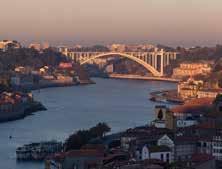

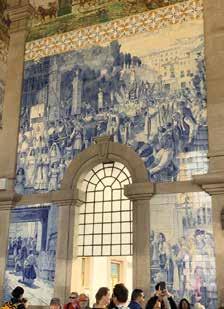
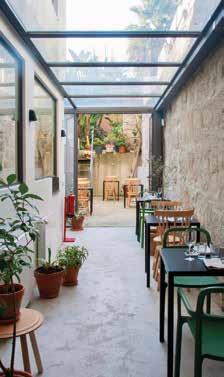
From the Cathedral your next visit must be to the Sao Bento Rail Station. Yes, a Railway station! But this is not an ordinary station as you realise once you enter. The entrance hall is something you will never forget as you are faced with over 20,000 tin-glazed blue and white tiles depicting scenes from Portugal’s defining historic moments, as well as country scenes, and as it’s a railway station, the history of transport.
Porto is blessed with many wonderful restaurants, but if you want something a bit special and different, I would suggest a restaurant a short 5-minute walk from Trindade Metro station (the station all metro lines pass through) called Tia Tia. The name comes from the owners’ names - TIAgo Feio and CaTIA Roldao, and it is a small restaurant lovingly serving local produce in inventive ways. The entrance is unassuming and is off a small street, and the restaurant is only open for breakfast and lunch Tuesday to Friday, 9am to 4pm, and for dinner Fridays and Saturdays between 7.30pm and 11pm, and as it is small, it is definitely worth booking.
Portuguese cuisine over the centuries has had a tendency to focus on meat dishes, but at Tia Tia this trend is bucked with the majority of dishes being vegetarian (although there is one fish dish). Vegetarian food is not only sustainable, it is very tasty when cooked well, and at Tia Tia, Tiago takes the fresh and vibrant vegetables and produces dishes of complexity which belie the simple surroundings with tastes that would not be out of place in any top restaurant in the world. As the weather in Porto was still a very pleasant 24 degrees, we decided to eat in the small courtyard garden at the back.
The menu is small, 4 dishes for lunch, and we ordered all of them to share between the two of us. The menu does change depending on the season, but when we were there the dishes were brioche, Hokkaido, kale, pomegranate (EUR 8), the roasted vegetables, coconut “escabeche” (EUR 8), 2 eggs, mushrooms, buckwheat (EUR 8) and horse mackerel, turnip, carrot (EUR 11).
Our first dish was an explosion of colours as on top of the lightly toasted brioche rested a vibrantly orange Hokkaido, fresh green kale and the red of pomegranate. It didn’t just look great, it tasted wonderful too. The star of this dish is the Hokkaido pumpkin, (which is so named as although it is a squash it looks like a pumpkin), as it was perfectly seasoned allowing its delicate chestnut flavour to burst through. The kale and pomegranate added texture as well as colour, along with a little sharpness. The roasted vegetables included pak choi, carrots, turnips and cauliflower sitting in a light and foamy sauce and were equally well cooked. The horse mackerel is sourced from the Atlantic and has been soaked in apple cider before being cooked, so the skin slightly burns when cooked whilst still keeping that distinct mackerel flavour. Squares of this mackerel sit in another delicate and creamy almond sauce interspersed with nuts and sharp pickled sliced turnip and diced carrot. Sustainability is a key concept here, and this also stretches to the wines with all of them being organic, and in that spirit, I selected a glass of not white, not red, not even rose, but orange! Orange wine is made from white wine grapes where the grape skins are not removed, and here the wine comes from those grown on the highest mountain in Portugal, and allegedly this wine is better for you than white wine, so I had to have a second glass to look after my health!
Having dined royally we took the metro over the Duoro river to Gaia to finish our first day’s visit to Porto with a tour of a Port maker.
When you think of port brands, names to conjure with include Wares, Dow, Cockburns and Graham’s, but it may surprise you to know that all of these brands, although producing different tastes, are all owned by the same company. We visited Graham’s port lodge, and please note that if you do decide to walk there, like we did, the road up to the lodge is steep!
Tours take place throughout the day, in a variety of languages, but it is vital you do book a tour before turning up. The tour starts with a film about the origins of the company and its owners, the Symington Family, who still own and work in it today, as well as showing the Duoro river valley where the grapes for the port are grown. From there you visit the ‘caves’, or cellar where the port is stored whilst it matures and improves. The sight of thousands of barrels stacked in rows is aweinspiring, and the size of some of the wooden vats is mind-blowing as they can store 73,000 litres of port each. What also strikes you is the sweet smell of the port everywhere whilst you are educated about the differences between a ruby, a tawny and a vintage port.
Our guide was exceptional, with a clear love for port and a vast knowledge of the Graham’s port lodge.
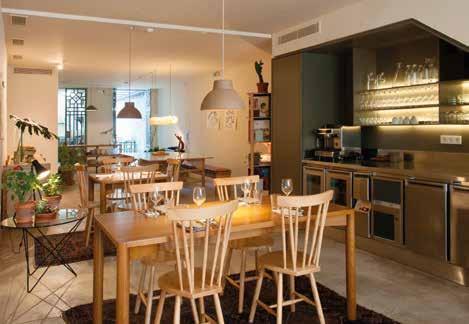
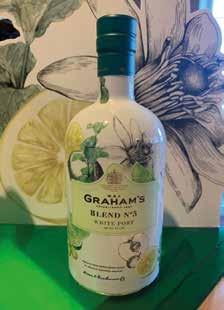
After passing through the owner’s personal port collection, which includes ports dating back to 1886, we finally got to taste some port ourselves. We settled into the Vintage room with comfortable armchairs looked down on by Winston Churchill, who was a great fan of Graham’s port, and were presented with 3 different ports to try, a Ruby Port and then a 10 and a 20-year-old tawny. Tours and tasting prices vary depending on the ports you would like to try, and having finished we couldn’t help buying a few bottles of their Six Grapes Ruby Port to take home!
After this tour we were exhausted having walked almost 18,000 steps, so gratefully made our way to our hotel M.Ou.Co.
M.Ou.Co is a boutique hotel offering a totally unique and quirky experience to add that extra wow to your Porto trip.
I have visited many hotels in my time across the world, but I have never experienced one like M.Ou.Co. Its concept can be summed up in the three words it has on its website - Stay, Listen, Play.
The hotel has risen from the ashes of an old metal factory, and is an eclectic mix of metal and concrete which plays a key part in the hotels ethos and has won them a few awards. The staff are exceptionally friendly and our check-in was quick and efficient, which was a blessing considering the pain emanating from my legs.
M.Ou.Co is a hotel that unashamedly caters for those who love music (and who doesn’t like music?), whilst also respecting every guest’s need for quiet time. In that spirit, every room has a record player and a selection of albums (yes I am old enough to remember vinyl) for guests to enjoy in their rooms, but at the same time each room is soundproofed so you only have to enjoy your music, not other peoples.
The rooms are nothing like you will have experienced before and are all minimalistic, but all have the same quirkiness with suites with a kitchen and garden, balcony rooms with a hanging chair to relax in, but do listen carefully to the instructions about how to operate things in the room as we totally failed to work out the lighting! Having finally worked out the lighting system so we didn’t turn every light in the room off every time we touched a switch, we decided to rest our weary bodies by the pool before having dinner.
The sun terrace is a real sun trap and is perfectly placed to pick up the sun for the majority of the day. On this terrace is a small pool which is more for a refreshing dip than one to do lengths in, but what more could you ask for from a city hotel?
M.Ou.Co continues it quirkiness by giving guests a mobile phone when they arrive, which is the electronic version of the old printed booklets you used to see in hotels telling you about everything the hotel has to offer. The difference here is that it also has the usual apps a phone has, and can be used as a guide to Porto as well as giving guests 15 minutes free international calls, so everything is in one handy device which is not only clever, but very useful.
M.Ou.Co is not in the centre of the town, but that really isn’t a problem, as it is a short walk from a Metro station that has regular trains into the centre, so you have the best of both worlds with a little less hustle and bustle of the centre, whilst being close enough to be able to get there quickly.
Prices are from EUR 85 per night. After a busy day exploring Porto, we decided to eat in the hotel, and were treated to wonderful food washed down with a very reasonable house white wine (well we are in the heart of wine country!) served by helpful and friendly staff.
After a rejuvenating night’s sleep and a hearty breakfast, including the famous Portugese Pasteis de Nata, delicious Portuguese custard tarts which we ate maybe one or two more of than we should have!, we were ready to re-engage with what Porto has to offer.
We decided to go to the Douro valley and see for ourselves if the landscape is really as beautiful as it is written it is. I can safely confirm that it is, and as we drifted down the Duoro river on our boat, the peace and tranquillity coupled with a clear blue sky and warming sun was magical. The terraced hillsides with their extensive vines not only produce some of the best wines, they also look like picture postcards, and it is not hard to see why this has been listed as a World Heritage Site.
We travelled by boat as there is something about being on water that is so relaxing, but you can get to the Valley by road, train or even helicopter, but allow enough time to not only enjoy the wineries and port lodges, but also to drink in the peace and quiet and take a little time off from the stress’ of life.
Porto is not a new city, far from it, but it is starting to become a place you should visit, and my final tip is to take a large suitcase with plenty of room left in it as you just have to bring back a bottle or two of port from where it is only allowed to be produced, as we didn’t, and our luggage was too heavy on the way back for our airline!!
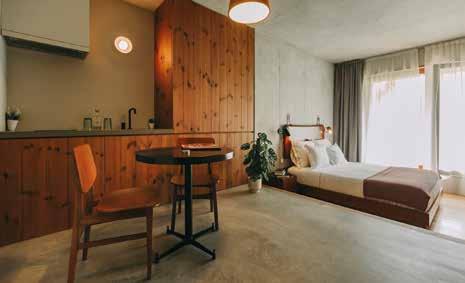
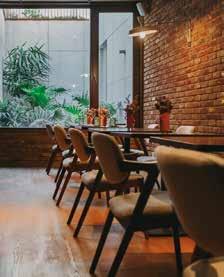

For further information please visit: www.instagram.com/tiatia.porto Hotel website: moucohotel.pt visitporto.travel











